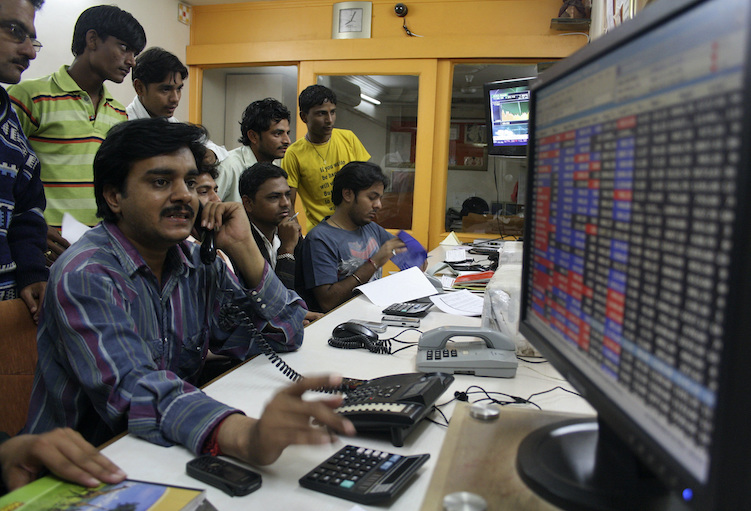Markets in the Asia-Pacific region were generally subdued on Tuesday – except for India, where nerves about the election outcome and the Modi government falling short of a landslide victory caused shares to plunge.
Indian stocks suffered their worst session since the onset of the Covid-19 pandemic, erasing recent gains before recovering some of those losses later in the day.
The NSE Nifty 50 index was down 7.2% as of 12.41pm IST before recovering to 5.9% down at 3.30pm, while the S&P BSE Sensex fell 6.6% before edging back to 5.74% down.
The indexes had jumped over 3% on Monday after exit polls projected that the BJP-led alliance was likely get a two-thirds majority in the lower house. With the day’s losses, the benchmarks are down nearly 1% so far this year.
ALSO SEE: China’s Property Debts Seen Weighing Down Economy for Years
Hang Seng edges up
Earlier in the day, the Nikkei in Japan slipped by 0.22%, while Australia’s S&P ASX 200 weakened 0.3% and South Korea’s Kospi fell 0.8%.
In China, the Shanghai composite added 0.4%, while the Hang Seng in Hong Kong edged up 0.2% to 18,444.11 at the close of trading.
Buyers have been enticed by signs of greater stability in the property sector, which has been in a prolonged slump. Hope that the US Federal Reserve will cut interest rates at some point later this year also warmed sentiment.
Tech and gaming conglomerate Tencent added 0.6% to HK$377.40, while Meituan, the food delivery giant, rose by 4.1% to HK$113.50 ahead of an earnings report later this week.
Longer and Hang Lung Property lead gains among property developers, with both rising by over 3%.
The Hang Seng has staged a 31% rebound from the year’s low last month, although traders have taken profits after patchy earnings and economic reports.
On the mainland, the state developer China Vanke, which is listed in Shenzhen, shot up by 7% after the company said home sales were up by over 11% in May over the previous month.
But shares of China’s three state oil conglomerates – PetroChina, Sinopec and CNOOC – fell by 1.7% to 1.9% on expectation that OPEC would extend production cuts.
All eyes on Indian poll outcome
Prime Minister Narendra Modi’s Bharatiya Janata Party (BJP)-led coalition was leading the ballot as India’s votes were counted late on Tuesday afternoon, but there were signs the BJP may fall short of a majority on its own as a united opposition led by the Indian National Congress made gains.
The reduced prospect of Modi’s alliance winning a strong majority rattled investors.
All sectors were in the red. Banks fell 7.9%, realty dropped 9.3%, infrastructure declined 13%, while oil and gas stocks lost 11.7% and state-run companies and public-sector banks retreated 19% and 18% respectively.
The small-cap and mid-cap were trading down 12.4% and 11.3%.
Adani Enterprises and Adani Ports led losses with a 25% fall each on the Nifty 50 index. Other Adani group stocks were down between 9% and 20%.
“The fear of the market is whether present numbers will stay or will reduce further. (Even at current majority) there will be some element of disappointment as they are below market expectations,” Mayuresh Joshi, head, equity research India at William O’Neil and Company, said.
“Markets were at an all-time high, a lot of hope was built up (on BJP’s majority) and these will unwind over the next few sessions and the focus will turn to policy announcements as the reforms will any way continue with BJP getting an absolute mandate,” he said.
Global shares slip, dollar drops
Global shares eased, meanwhile, as investors considered the prospect that the US economy’s “exceptionalism” may be starting to unwind as manufacturing activity there further weakened, in turn pushing the dollar to multi-month lows.
The dollar skimmed its lowest in over two months against the euro and the pound, while US government bond yields have retreated over the past six weeks, as investors have bought into the idea that the economy is slowing enough to warrant rate cuts this year.
The MSCI All-World index was last down 0.2%. Stocks in Europe also took a breather, pushing the STOXX 600 lower for the first time in four days, down 0.5%.
This week brings a slew of major data. The strength of the US labour market will be closely watched in the new few days with the Job Openings and Labor Turnover Survey (JOLTS) due to be published later on Tuesday. Non-farm payroll figures for May are out on Friday.
“We’re expecting a slight easing in demand for labour in the US market,” Raisah Rasid, JPMorgan Asset Management’s global market strategist, said.
“What does that mean for the Fed? I think all data points to one interest rate cut later in the year, potentially in December. If the data moves quicker than expected that cut could be moved forward to September.”
On Monday, US Treasury yields fell to the lowest point in two weeks, after the country’s manufacturing activity slipped for the second consecutive month in May.
The yield on benchmark 10-year Treasury notes fell 2 basis points to 4.381%, while the two-year yield, which rises with traders’ expectations of higher Fed fund rates, fell 1 bps to 4.8058%.
The dollar fell 0.4% against the yen to 155.39, around its lowest for two weeks and nearly 3% down from late April’s multi-year high at 160.03.
The euro was down 0.2% on the day at $1.0881, having gained 0.65% in a month, while the dollar index, which tracks the greenback against a basket of currencies of other major trading partners, held around 104.
US crude fell 1.8% to $72.88 a barrel. Brent crude fell 1.6% to $77.10. Both benchmarks hit four-month lows on Monday after OPEC+ agreed to start unwinding some production cuts from October.
Gold was slightly lower, falling 0.6% to $2,335 an ounce.
- Reuters with additional input and editing by Jim Pollard
























